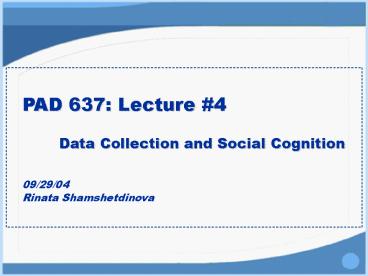PAD 637: Lecture - PowerPoint PPT Presentation
1 / 12
Title:
PAD 637: Lecture
Description:
'Planting' an observer in a room. Random appearance, each time over a ... Slightly obtrusive observation has no noticeable effect on informant accuracy. ( BKS) ... – PowerPoint PPT presentation
Number of Views:72
Avg rating:3.0/5.0
Title: PAD 637: Lecture
1
PAD 637 Lecture 4 Data Collection and
Social Cognition 09/29/04 Rinata Shamshetdinova
2
Techniques for social data collection/1
- questionnaires
- roster vs. free call
- free vs. fixed choice
- ratings vs. complete ranking
- interviews
- face-to-face
- telephone
- observations
- Planting an observer in a room
- Random appearance, each time over a limited period
1
3
Techniques for social data collection/2
- archival records
- structured data sets
- unstructured data sets (coding required)
- experiments
- planting rumors
- small world
- others
- social cognitive structures
- ego-centered
- small world
- diary
2
4
Boundary Specifications Sampling
- 2 approaches to boundary definition
- Nominalist approach analyst self-consciously
imposes a conceptual framework constructed to
serve his or her own analytic purposes. - Realist approach the boundaries of the social
entities are defined by actors themselves. Social
entity exists as a collectively shared subjective
awareness of all, or at least most, of the
actors. - Sampling
- Relevant sampling units?
- Estimation of network properties based on
sampling units - Snowball network sample
3
5
Information accuracy
- technical aspect - the accuracy of data
collection - What data do we need?
- cognitive aspect the accuracy of informants
- Krackhardt behavioral measures of interaction
are not very closely related to participants
self reports of the same interactions often
recall is being used as a surrogate of behavior. - Bernard, Killworth and Sailer about 52 of what
informants said was wrong. - Freeman, Freeman and Romney people's recall of
their interactions with others is systematically
biased toward what is normal and/or logical
recalling important people more then others.
4
6
Cognitive Social Structures
- CSS
- sender
- receiver
- perceiver
- Rijk person k thinks that person i approaches
person j for help and advise - Characteristics
- Amount of information in CSS gt that in
traditional SS ? problems in data collection - No assumption is made about the perceptions
being correlated with each other.
5
7
Useful bits/1
- Informants who usually kept records of their
behavior were not more accurate than those who
did not. (BKS) - Slightly obtrusive observation has no noticeable
effect on informant accuracy. (BKS) - Telling people in a group that they are expected
to get more accurate in repeated experiments over
time produces no significant improvement in
accuracy of reporting communications. (BKS) - Asking people who do you like? produces about
the same answers as asking them who do you talk
to? (BKS) - Asking people about the significance or
importance of their interactions with others is
of little use, since it produces no better
results than simply asking them who they talked
to. (BKS)
6
8
Useful bits/2
- In general, the more recent the time of the
window over which informants report their
communication, the more accurate they tend to be.
However, only 6 of informant accuracy can be
accounted for by this factor. (BKS) - Over all data sets, people can recall or predict
less than half of their communications, measured
either on amount or on frequency. (BKS) - For publicly available information there was
both agreement and accuracy. For questions where
the answers were not public, there was very
little agreement, and hence high inaccuracy.
(Young Young) - People represent enduring patterns of
interaction more accurately then individual
instances of behavior (FR)
7
9
Question 1
- Does agreement presupposes accuracy, especially
when we deal with a closely-knit network? Under
what conditions would it be true?
8
10
Question 2
- Accuracy vs. problems in data collection and
treatment should we, at this stage use Cognitive
Social Structures in our Empirical Exercises?
9
11
Question 3
- Under what circumstances can random sampling be
used???
10
12
(No Transcript)































